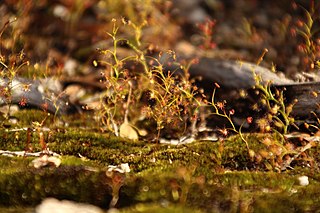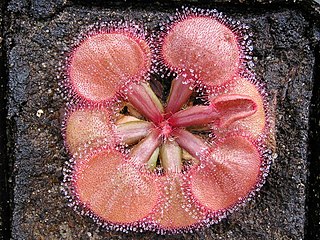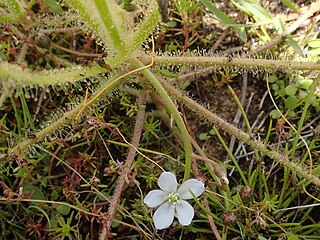
Drosera adelae, commonly known as the lance-leaved sundew, is a carnivorous plant in the genus Drosera that is endemic to Queensland, Australia.

Drosera monticola is a perennial carnivorous plant species in the genus Drosera, the sundews. This species is endemic to a single mountain range in Western Australia.

Drosera bicolor is an erect perennial tuberous species in the genus Drosera that is endemic to Western Australia. It produces a basal rosette of leaves similar to that of D. peltata and the stem grows to 11 cm (4 in) high. Its white flowers that have a red spot near the petal base emerge from September to October. D. bicolor grows in deep silica sand on heathland along the upper Phillips River and south-east of Lake King.

Drosera erythrogyne is a scrambling or climbing perennial tuberous species in the genus Drosera that is endemic to Western Australia. It grows in soils that are peat-sand to loam and occurs in an area along the southern Western Australian coast west of Albany in swamps or near granite outcrops. It produces small leaves along a long, scrambling stem that can grow to 2–3 m (7–10 ft) long. White flowers emerge from August to October.

Drosera gigantea, the giant sundew, is an erect perennial tuberous species in the carnivorous plant genus Drosera that is endemic to Western Australia. It grows in sandy soils at the margins of swamps and near granite outcrops along the Western Australian coast from Albany north to just south of Geraldton. D. gigantea produces small shield-shaped leaves along many lateral branches that look like a small tree. Individual plants can grow up to 0.2–1 m (0.7–3.3 ft) tall. Because of its tall, tree-like form, it is considered one of the largest Drosera species. It is also easily cultivated and enjoys damp, humid conditions often provided in greenhouses. White flowers emerge from August to November. The red tubers of this species can grow to be 3.8 cm (1.5 in) in diameter and may be a metre below ground.

Alastair S. Robinson is a taxonomist and field botanist specialising in the carnivorous plant genus Nepenthes, for which he is regarded as a world authority. He is currently Manager Biodiversity Services at the National Herbarium of Victoria, Royal Botanic Gardens Melbourne, where he oversees identification botany services, the Library and Artwork components of the State Botanical Collection, and the botanical journal Muelleria, a peer-reviewed scientific journal on botany published by the Royal Botanic Gardens Victoria, for which he is Editor in Chief.

Drosera menziesii, the pink rainbow, is an erect or scrambling perennial tuberous species in the carnivorous plant genus Drosera. It is endemic to Western Australia and grows in a variety of habitats, including winter-wet depressions, swamps, and granite outcrops in clay or peat sand soils or loam. D. menziesii produces small, circular carnivorous leaves along an undulating erect stem that can be .05–1.1 m (0.2–3.6 ft) high. Its pink flowers emerge from July to November.

Drosera falconeri is a carnivorous plant in the family of Droseraceae. It is endemic to the Northern Territory of Australia.

Drosera lanata is a carnivorous plant in the genus Drosera and is endemic to the Northern Territory and Queensland in Australia. Its leaves are arranged in a compact basal rosette. Narrow linear petioles less than 2 mm wide emerge from the center of the rosette and hold carnivorous leaves at the end. Both petioles and the center of the rosette are densely covered in silvery dendritic hairs. These dendritic hairs afford the plant insulation and allow it to trap morning dew for additional moisture during the dry season. The leaf lamina is maroon-red and 2 mm long by 2.5 mm wide.

Drosera finlaysoniana is a carnivorous herb found in Australia and south east Asia. More commonly found in the north of Australia. In southern Australian sites it has been recorded at inland areas, in eucalyptus woodlands subject to flooding. Also found in Hainan, Taiwan, the Indo-China region and the Philippines.

Drosera citrina is a pygmy sundew, a type of carnivorous plant. It is native to Western Australia. The Latin specific epithet citrina means "lemon coloured", referring to the colour of the flowers. It is closely related to Drosera nivea, which was considered a variety of D. citrina in the past called Drosera citrina var. nivea
Drosera nivea is a species of carnivorous plant. It is a pygmy sundew and is native to Western Australia. The specific epithet nivea is derived from the Latin word niveus, meaning white, in reference to the colour of the plant's flower. It is closely related to Drosera citrina and has previously been considered a variety of D.citrina known as D. citrina var. nivea.
Andreas Fleischmann is a German botanist specialising in carnivorous plants, particularly Droseraceae and Lentibulariaceae. He has (co-)published at least 46 new taxa including 14 species of Drosera (sundews), 7 species of Genlisea, 8 species of Heliamphora and 3 species of Pinguicula (butterworts).
Drosera aquatica is a species of sundew endemic to the Northern Territory and Western Australia. It was first described by Allen Lowrie in 2013. Like other members of Drosera sect. Arachnopus it is an annual therophyte.

Drosera aurantiaca is a species of sundew endemic to the Northern Territory and the north of Western Australia. It was first described by Allen Lowrie in his 2014 Carnivorous Plants of Australia Magnum Opus. Like other members of Drosera sect. Arachnopus it is an annual therophyte.
Drosera barrettiorum is a species of sundew endemic to the north of Western Australia. It was first described by Allen Lowrie in his 2014 Carnivorous Plants of Australia Magnum Opus. Like other members of Drosera sect. Arachnopus it is an annual therophyte.
Drosera cucullata is a species of sundew endemic to the north of Western Australia and the Northern Territory. It was first described by Allen Lowrie in his 2014 Carnivorous Plants of Australia Magnum Opus. Like other members of Drosera sect. Arachnopus it is an annual therophyte.
Drosera fragrans is a species of sundew endemic to the north of Western Australia and the Northern Territory. It was first described by Allen Lowrie in his 2014 Carnivorous Plants of Australia Magnum Opus. Like other members of Drosera sect. Arachnopus it is an annual therophyte.
Drosera maanyaa-gooljoo is a species of sundew endemic to the Kimberley region of Western Australia. It was first described by Andreas Fleischmann and Thilo Krueger in 2023. The type material was collected much earlier, in 1982, but was originally categorised within D. indica and later as a form of D. fragrans. Like other members of Drosera sect. Arachnopus it is an annual therophyte.












